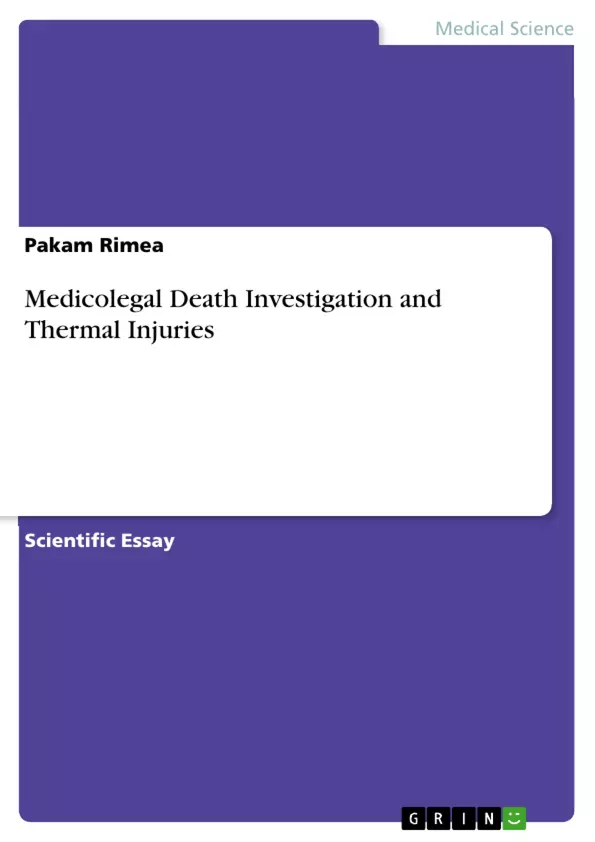This document describes the most common types of thermal injuries in-depth from the perspective of the medico-legal death investigator. It cites the latest knowledge in order to compare and contrast thermal injuries, provides data on how a death investigator can distinguish between injury types, and explores the effects of exposure to different heat sources on the body. The text also advises the death investigator on how to establish identity and cause of death, even when a body has been badly disfigured.
Inhaltsverzeichnis (Table of Contents)
- Forensic Pathology of Thermal Injuries
- Thermal Injuries
- Radiant Burns
- Chemical Burns
- Electrical Burns
- Identification of Victims of Fire
- Identification of Victims of Electrical Burns
- Cause of Death
Zielsetzung und Themenschwerpunkte (Objectives and Key Themes)
This text explores the forensic pathology of thermal injuries, specifically focusing on the identification of burn victims and determining the cause of death. It examines different types of burns, including those caused by heat, chemicals, and electricity, and discusses the specific characteristics and challenges they pose for investigators.
- Types of thermal injuries (heat, chemical, electrical)
- Characteristics and severity of burns
- Identification of burn victims
- Determination of cause of death
- Challenges in forensic investigation of thermal injuries
Zusammenfassung der Kapitel (Chapter Summaries)
- Forensic Pathology of Thermal Injuries: This section introduces the concept of thermal injuries, their various types, and their impact on the human body. It highlights the importance of forensic investigation in identifying burn victims and establishing the cause of death.
- Thermal Injuries: This chapter delves into the different classifications of thermal injuries based on severity, from first-degree burns to charring. It discusses factors influencing the extent of damage, such as time of exposure and the type of heat source.
- Radiant Burns: This section focuses on burns caused by radiant heat, such as exposure to electromagnetic waves. It examines the effects of varying radiant heat temperatures and durations, and explores how these burns differ from other types.
- Chemical Burns: This chapter discusses chemical burns caused by contact with acids and alkalis. It explains how chemical agents interact with bodily tissues, leading to different types of necrosis and characteristic burn patterns.
- Electrical Burns: This section explores the complexities of electrical burns, highlighting the role of amperage and voltage in causing injury. It discusses the characteristic signs of electrical burns, including entry and exit points, and the challenges in distinguishing between antemortem and postmortem burns.
- Identification of Victims of Fire: This chapter addresses the difficulties in identifying victims of fire, where burn damage can obliterate identifying features. It examines the ways in which investigators can still identify victims through preserved tissues, dental records, and other unique characteristics.
- Identification of Victims of Electrical Burns: This section details the methods used to identify victims of electrical burns, focusing on distinguishing between high and low voltage electrocutions. It highlights the presence or absence of electrical burns, the pattern of tissue damage, and other specific indicators.
- Cause of Death: This chapter emphasizes the importance of autopsy in determining the cause of death in cases of thermal injuries. It discusses the need for toxicology analysis and other post-mortem examinations to establish whether death was directly caused by the burns or by complications related to the injuries.
Schlüsselwörter (Keywords)
This text explores the forensic pathology of thermal injuries, focusing on key concepts such as burn severity, identification of victims, and determination of cause of death. It examines various types of burns, including those caused by heat, chemicals, and electricity. The text also highlights the challenges faced by investigators when dealing with burn victims, particularly in identifying victims and establishing the cause of death.
- Quote paper
- Pakam Rimea (Author), 2013, Medicolegal Death Investigation and Thermal Injuries, Munich, GRIN Verlag, https://www.grin.com/document/284741



